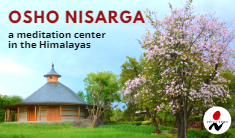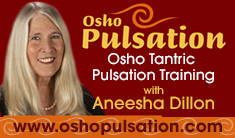About Osho
Osho: A Contemporary Mystic
 Osho (formerly Bhagwan Shree Rajneesh) teaches meditation not as a practice but as a way of life. He is a mystic who brings the timeless wisdom of the East to bear upon the urgent questions facing men and women today. He speaks of the search for harmony, wholeness, and love that lies at the core of all religious and spiritual traditions, illuminating the essence of Christianity, Hassidism, Buddhism, Hinduism, Sufism, Tantra, Tao, Yoga, and Zen. Osho’s vision is of a new man.
Osho (formerly Bhagwan Shree Rajneesh) teaches meditation not as a practice but as a way of life. He is a mystic who brings the timeless wisdom of the East to bear upon the urgent questions facing men and women today. He speaks of the search for harmony, wholeness, and love that lies at the core of all religious and spiritual traditions, illuminating the essence of Christianity, Hassidism, Buddhism, Hinduism, Sufism, Tantra, Tao, Yoga, and Zen. Osho’s vision is of a new man.
Osho speaks on virtually every aspect of the development of human consciousness. His talks cover a staggering range – from the meaning of life and death to the struggle of power and politics, from the challenges of love and creativity to the significance of science and education. He belongs to no tradition.
To know oneself is to know all. And that is the only thing I emphasize; no belief, no dogma, no creed, no church, no religion. By a simple process of inner observation you come to realize yourself... Truth is within – seek not elsewhere.
Osho is a striking modern-day example of the millennia-old Eastern tradition of enlightened Masters. In the East, enlightenment is described as the state of ultimate and total consciousness or awareness, as attained by Gautama Buddha, Socrates, and others.
The function of a Master is to provoke consciousness in others, frequently by unexpected or apparently irrational acts and behavior; and to provide an environment in which a disciple can experience meditation for himself. It is therefore with a very different perception that we must view such a man’s life, as our standard criteria simply do not apply.
History tells of Bodhidharma entering the Emperor’s court with a shoe on his head or of Japanese Zen Masters planting trees upside down. Such acts can only be understood within the context of the Master’s constant efforts to bring his disciples into the Now, into meditation, and ultimately, to enlightenment. Osho is such a Master.
Osho was born December 11, 1931, in Kuchwada, a small village in the state of Madhya Pradesh, central India. He became enlightened at the age of 21 on March 21, 1953, while majoring in philosophy at D.N. Jain College in Jabalpur.
In 1966 Osho left his post as a professor of philosophy at the University of Jabalpur to devote himself to the raising of human consciousness. A powerful and passionate debater, he traveled widely in India, speaking to large audiences and challenging orthodox religious leaders in public debates and began to address gatherings of 50,000 to 100,000 in the open-air maidans of India’s major cities, using the name of Acharya Rajneesh. Four times a year he conducts intense 10-day meditation camps. During these camps he introduced his revolutionary meditation technique, Dynamic Meditation, which begins with a period of uninhibited movement and catharsis, followed by a period of silence and stillness.
Most traditional meditation techniques require one to sit still and silent. But Osho understood that for most of us accumulated stress in our body/mind makes that difficult. Before we can enter our inner silent spaces, we need to let go of our tensions. Over the years Osho designed many more such active meditations, lie Kundalini Meditation, Nataraj Meditation, Nadabrahma Meditation, and others. These active meditation techniques have been used by psychotherapists, medical doctors, teachers, and other professionals around the world.
In 1974 Osho moved to Pune (then Poona) where an ashram was established so that Osho would be able to focus his attention on the seekers he had started to initiate. He made it clear that his Neo-Sannyas or discipleship – a path of commitment to self-exploration and meditation – does not involve renouncing the world. Seekers from around the world started arriving and Osho, who was known at this time as Bhagwan Shree Rajneesh, gave a 90-minute discourse nearly every morning from 1974 to 1981, alternating every month between Hindi and English. His discourses offer insights into all the major spiritual paths, including yoga, Zen, Taoism, Tantra, and Sufism, as well as word teachers such as Gautama Buddha, Jesus, Lao Tzu, and other mystics. These discourses have been collected into over 300 volumes and translated into every major language of the world.
Additionally, the commune offered a wide variety of therapy groups combining Eastern meditation techniques with Western psychotherapy. Therapists from all over the world were attracted, and by 1980 it had become an international community with a reputation as the world’s finest growth and therapy center, with 100,000 people passing through the ashram gates each year.
In 1981, Osho traveled to the US where his American disciples purchased a 64,000-acre ranch in the central Oregonian high desert and invited him to visit. The city of Rajneeshpuram was incorporated and provided services for 5,000 residents. It became the largest and most controversial spiritual community ever pioneered in the US, and a target for many politicians who made inflammatory speeches against it.
In September 1985, Osho’s personal secretary and several members of the commune’s management suddenly left, and a whole pattern of illegal acts they had committed was exposed. Osho invited law enforcement officials to investigate the crimes committed by the group, but the authorities saw this as a golden opportunity to destroy the commune entirely. Federal and local officials arrested Osho at gunpoint without warrants and held him without bail for 12 days.
Fearing for his life, attorneys agreed to an Alford Plea on two out of 35 charges brought against him by a federal grand jury in secret session. (According to the rules of the plea, the defendant maintains innocence while saying that the prosecution could have convicted him.) Osho was fined $400,000 and deported from America. The US Attorney in Portland, Charles Turner, later publicly conceded that the government was intent on destroying Osho’s commune.
Over the next two years, the government of 21 countries denied Osho entry or deported him after arrival. In 1986 Osho returned to India and later to the ashram in Pune where he started giving discourses again. Quickly the ashram fills again with seekers from all over the world.
In early 1989 Osho stopped using the name “Bhagwan” and accepted the address “Osho,” which derived from ancient Japanese. His health declining, he stopped giving talks in August and instead began to make daily appearances for evening darshan, sitting in silence while music was played. “That which cannot be said has to be experienced. This is a geat experience of getting into an inner, meditative space.”
Osho left his body on January 19, 1990. Just before his departure from the body, he said, “Never speak of me in the past tense. My presence here will be much greater without the burden of my tortured body.”
Today, more than 20 years later, his words are proved true. Thousands upon thousands of disciples and visitors come to the Pune ashram (now called Osho International Meditation Resort) and other Osho centers around the world. His talks, spoken over 30 years, recorded on audio and video, and published in hundreds of books are more popular than ever. In 2009, for example, three and a half million of his books were sold worldwide.
Osho Viha Information Center is devoted to spreading Osho’s message through the distribution of Osho books, DVDs, MP3s, and CDs. Osho's words, spoken spontaneously over the years, and his active meditations, are recognized around the world as is his insight into meditation, Tantra, Zen, relationships, and all aspects of life. His work was not a religion but a way of life, a method of revealing and living our full potential, from birth to death.
Osho Viha Information Center is proud to supply books, DVDs, MP3s, tapes, CDs, videos, Tarot cards, and other reflections of Osho’s work, to you through this web site. Please use the links on this page to find the Osho material you want and contact us. We are always happy to assist you.










